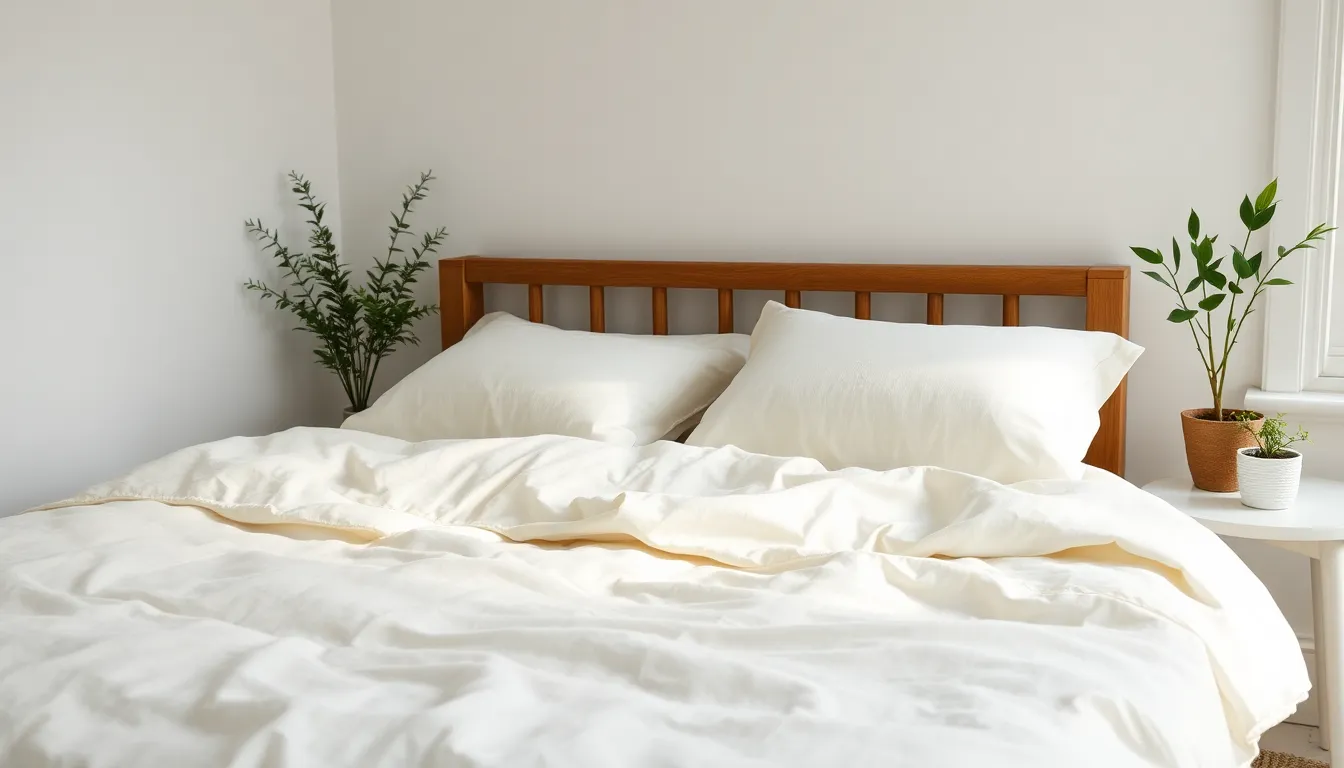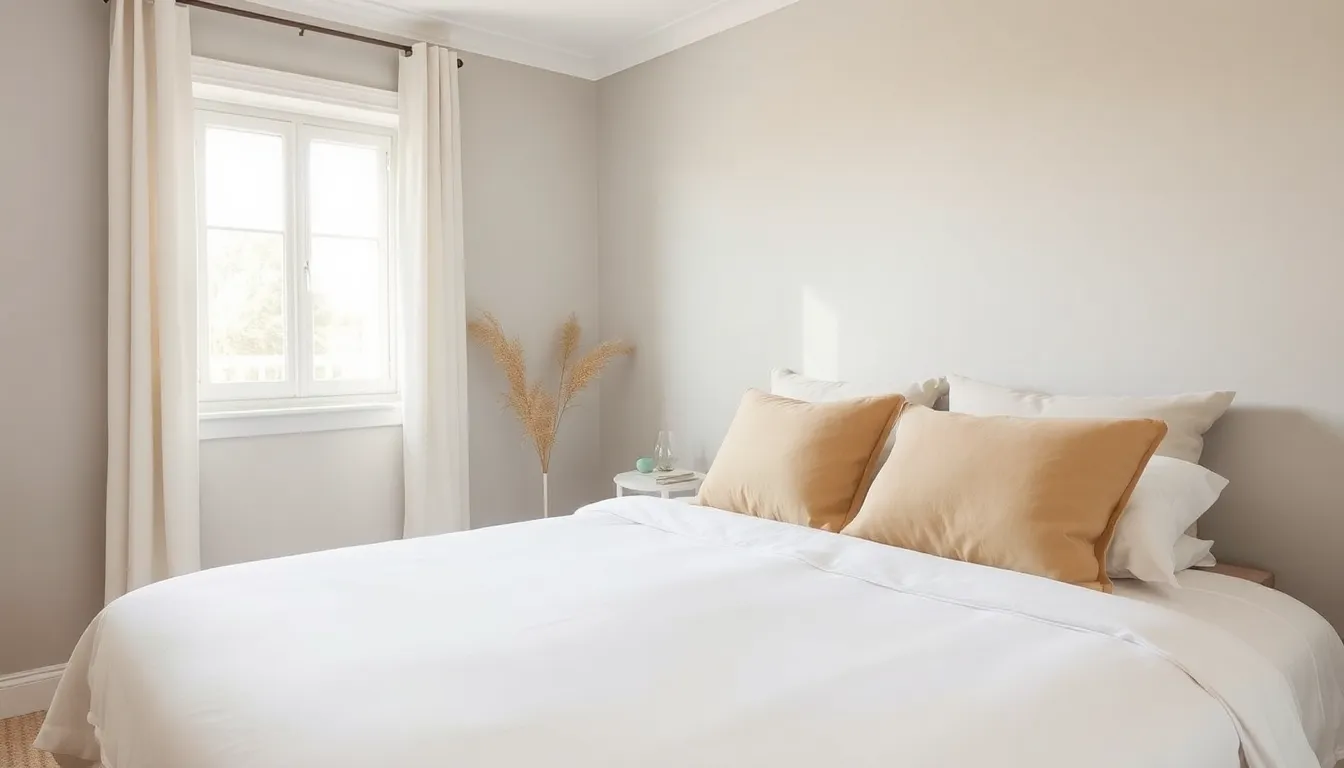In a world overflowing with distractions, minimalist bedding offers a refreshing escape. Imagine transforming your bedroom into a serene sanctuary where less truly is more. It’s not just about tossing out the frills; it’s about embracing simplicity and style that speaks volumes without shouting.
Minimalist bedding champions clean lines and neutral tones, creating a calming atmosphere perfect for a good night’s sleep. Plus, who doesn’t want to spend less time making the bed and more time dreaming about beach vacations? By choosing quality over quantity, minimalist bedding makes your space feel larger and your life a tad less chaotic. So, ready to ditch the clutter and elevate your sleep game? Let’s dive into the world of minimalist bedding and discover how it can revolutionize your bedroom.
Table of Contents
ToggleWhat Is Minimalist Bedding?
Minimalist bedding emphasizes simplicity and functionality in the bedroom. This approach prioritizes clean lines and neutral colors, creating a serene environment that promotes relaxation.
Key Characteristics
Simple designs define minimalist bedding. Typically, it incorporates soft colors like whites, grays, and beiges for a calm appearance. High-quality materials, such as organic cotton and linen, contribute to comfort and durability. Quality bedding rarely features excessive patterns or embellishments. Efficient storage solutions often accompany minimalist bedding, ensuring a tidy space. Versatile accessories, like lightweight blankets and decorative pillows, allow for subtle personalization without clutter.
Benefits of Minimalist Bedding
Adopting minimalist bedding enhances the visual appeal of a bedroom. The spacious feel achieved through fewer items invites tranquility and relaxation. Simple maintenance becomes a significant advantage, leading to a quicker bed-making routine. Increased clarity in design often reduces sensory overload, fostering a peaceful atmosphere for sleep. Mindful choices in bedding support environmental sustainability, as quality materials typically last longer and minimize waste. Ultimately, this bedding style promotes a serene lifestyle, encouraging restfulness in daily routines.
Choosing the Right Materials

Selecting the right materials plays a crucial role in achieving the essence of minimalist bedding. Quality and sustainability often stand as top priorities for individuals embracing this style.
Organic Fabrics
Organic fabrics, such as cotton and linen, offer comfort and breathability. Derived from non-GMO sources, organic cotton avoids harsh chemicals found in conventional farming practices. Linen, crafted from flax, provides durability along with a natural texture. Choosing these materials ensures minimal environmental impact while promoting healthy sleep. Additionally, opting for organic fabrics often results in softer bedding that becomes more comfortable with each wash.
Sustainable Options
Sustainable options extend beyond organic fabrics. Bamboo sheets exemplify eco-friendly choices, as bamboo grows rapidly and requires less water compared to conventional crops. Tencel, made from sustainably sourced wood, showcases its ability to regulate temperature and wick moisture. Recycled materials also serve as excellent alternatives, contributing to reduced waste. Embracing these sustainable choices helps create a minimalist bedding environment that aligns with eco-conscious values while enhancing overall aesthetic appeal.
Design Considerations
Design considerations play a vital role in achieving the essence of minimalist bedding. Thoughtful choices in color palettes, textures, and patterns contribute significantly to the desired atmosphere.
Color Palettes
Neutral colors dominate minimalist bedding. Whites, light grays, and soft beiges create a serene backdrop. Subtle tones promote tranquility while making spaces feel more expansive. Incorporating shades like muted greens or gentle blues introduces a hint of color without overwhelming the senses. Many individuals find that limiting the color scheme to two or three hues ensures cohesiveness in the overall design. Selecting a monochromatic palette enhances visual harmony, minimizing distractions and promoting relaxation.
Textures and Patterns
Textures enhance the sensory experience of minimalist bedding. Crisp cotton and soft linen fabrics offer comfort and breathability, essential for restful sleep. Varied textures prevent monotony while maintaining simplicity. Layering different materials contributes depth without introducing excessive visual clutter. Natural fibers provide an organic feel, aligning with eco-conscious choices. Avoiding bold patterns preserves the clean aesthetic typical of minimalist design. Subtle, understated patterns, such as small stripes or delicate weaves, can add interest without detracting from the overall serenity.
Creating a Minimalist Bedding Setup
A minimalist bedding setup requires careful selection of essential items and strategic arrangement. Prioritizing simplicity fosters a calm environment.
Essential Items
Focus on a few high-quality essentials. Choose a crisp white duvet cover for a timeless look. Incorporate organic cotton or linen sheets for breathability and comfort. Add a lightweight blanket for warmth during colder nights. Consider simple pillows in neutral shades, as they provide support without overwhelming the aesthetic. Opt for a streamlined mattress without flashy designs to maintain a cohesive theme. Selecting these key pieces ensures the bedding setup remains functional while upholding minimalist principles.
Arrangement Tips
Prioritize space and organization in your arrangement. Place the duvet neatly at the foot of the bed to create a visually clean look. Layer the pillows in the back for an inviting appearance. For beds with side tables, keep decorations minimal on those surfaces. Arrange items like lamps or books to avoid clutter, ensuring they serve practical purposes. Maintain clear pathways around the bed to enhance the sense of openness. By considering these tips, individuals can create an effortlessly minimalist atmosphere that supports relaxation.
Maintenance and Care
Maintaining minimalist bedding focuses on simplicity and efficiency. Proper care ensures longevity while retaining the bedding’s fresh appearance.
Washing Instructions
Washing minimalist bedding involves specific considerations to preserve quality. Use cold or warm water settings for washing cotton or linen fabrics, aiming for mild detergents free from bleach. Avoid fabric softeners, as they can leave residues that diminish breathability. Washing bed items every one to two weeks keeps them fresh, while gentle cycles prevent damage. When drying, opt for low heat to prevent shrinkage and fading, or air dry for added care. Ensuring items are thoroughly dried before putting them away helps maintain softness and avoid musty odors.
Storage Solutions
Effective storage solutions enhance the minimalist aesthetic while maximizing space. Use breathable fabric bins or baskets for storing extra sheets and blankets to maintain organization. Stack linens neatly, ensuring easy access and visibility. Reduce clutter by keeping only essential items within reach. Utilizing under-bed storage also optimizes space in smaller rooms. Choose items that blend into the bedroom’s color palette to maintain visual harmony and create an uncluttered environment. Establishing a routine for seasonal transitions allows for efficient management of bedding inventory.
Embracing minimalist bedding can transform any bedroom into a serene retreat. By prioritizing simplicity and quality, individuals can create a calming environment that promotes restful sleep. The focus on neutral colors and high-quality materials not only enhances the visual appeal but also supports sustainable living.
With thoughtful design and efficient storage solutions, minimalist bedding encourages a clutter-free space that feels more open and inviting. This approach not only simplifies maintenance but also aligns with eco-conscious values. Adopting minimalist bedding is a step toward a more peaceful lifestyle, fostering tranquility and comfort in everyday routines.



